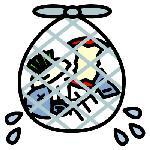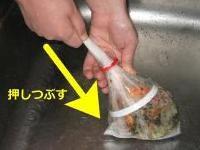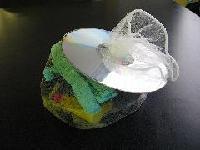We are collecting ideas for draining kitchen waste
Since the introduction of the waste charging system in October 2004, the city has achieved the waste reduction target of "15 percent reduction compared to fiscal year 2003 per person per day" set in the Basic Plan for General Waste Management, thanks to the cooperation of the citizens. By fiscal year 2007, we had reached this goal and have been working to reduce waste year by year, achieving a 21.1 percent reduction compared to fiscal year 2003 by fiscal year 2011.
On the other hand, looking at the results of the waste composition analysis conducted in fiscal year 2011, about 40% of combustible waste consists of "kitchen waste." Among this, the moisture content of "kitchen waste" is about 70%, and as we aim for further waste reduction in the future, "draining kitchen waste" has become a significant challenge.
Reducing "kitchen waste" not only decreases the amount of garbage but also allows you to switch to a smaller size of garbage bag than you usually use at home, which can have a positive impact on your household budget.
In addition, the benefits brought by "draining kitchen waste" are not limited to just this.
An example of the positive effects of "draining kitchen waste"
- Reduction of unpleasant odors
(When moisture is low, odors are less likely to occur) - Prevention of Crow Damage
(When there is less moisture, there is also less odor, making it difficult for crows to approach.) - Reduction of carbon dioxide emissions generated during the incineration of collected waste
(When there is less moisture, it can be burned efficiently, leading to energy savings)
This page introduces simple methods for draining kitchen waste that you can easily practice at home, so we encourage everyone to try "draining kitchen waste" and help reduce garbage.


Call for Ideas on "Draining Kitchen Waste"
The Living Environment Division is seeking ideas related to "draining kitchen waste" that you practice at home.
The application forms are available at the Living Environment Division counter, and you can also download and fill them out from the link below.
After filling it out, please bring it to the Living Environment Division counter, or send it via fax or email.
Please note that the ideas you submit may be introduced to the public through city publications and the Inagi City Website, as in the "Ideas for Reducing Food Waste" collection below, to widely encourage citizens to reduce waste. Thank you for your understanding.
Submission and Inquiry Contact
Living Environment Division Waste and Recycling Section
Phone 042-378-2111 (Extension 302, 303, 304)
Fax 042-378-3310
Ideas for Draining Kitchen Waste
Here are some of the ideas we received from everyone regarding "draining kitchen waste."
Please share your tips and recommendations for draining kitchen waste at home.
- Items with relatively low moisture content, such as vegetable peels, should be placed in a basket or colander and left by a window to dry before disposal. Since moisture may be released, it is advisable to place a food tray underneath.
Conversely, items that contain a lot of moisture can be placed in containers that have been used for water-filled miso or yogurt, and by soaking them in water again, you can extract more moisture when draining. (Momura resident, female) - Cut a small portion of the end of the used food storage bag, place the kitchen waste in a draining bag inside it, and then squeeze it to drain more water without getting your hands dirty. (Resident of Higashi-Naganuma, Female in her 30s to 40s)
- First, do not wet it. Put the kitchen waste in a plastic bag, let it drain overnight, and throw it away when it is completely dry. (Resident of the city, female)
- Drain the water well and wrap it in newspaper. Alternatively, bury it in the field. (Resident of Sakahama, male in his 70s)
- Leave it for a while. (Resident of Oshitate, Male in his 30s to 40s)
- Do not dispose of vegetable peels and ends in the sink; instead, throw them directly into the trash or find ways to avoid getting them wet. (Resident of the city, female)
- Cut the torn stockings and use them as drainage bags, then dispose of them in small portions. (Resident of the city, female)
If you have any other ideas for reducing waste, please let us know.
- Carrot and radish peels are shredded and eaten as kinpira. If there isn't enough to make kinpira, they can be added early when stir-frying or boiling, just like root vegetables, so they soften and can be eaten. Vegetable peels are high in fiber and nutrients, so I try to eat them instead of throwing them away as waste. (Resident of Momura, female)
- Spread tea leaves on the soil of the plants. (Resident of Higashi-Naganuma, woman in her 30s to 40s)
- First, do not sell! Do not buy! A society of reuse! (Resident of the city, female)
- Use a kitchen waste disposal machine. (Resident of the city, female)
Note: In the future, we will continue to introduce ideas received from everyone on the Inagi City Website!
Easily drain water using unwanted plastic bottles and CDs!
(Note) When using PET bottles, be sure to cover the cut edges with vinyl tape for protection.


In addition, the Living Environment Division provides subsidies for a portion of the purchase cost for those who buy composting containers as part of waste reduction measures.
For details on how to apply, please see the information on a separate page.
Please let us know your feedback on how to make our website better.
Inquiries about this page
Inagi City, Department of Urban Environment and Development, Living Environment Division
2111 Higashi-Naganuma, Inagi City, Tokyo 206-8601
Phone number: 042-378-2111 Fax number: 042-377-4781
Contact the Living Environment Division, Urban Environment Management Department, Inagi City



















